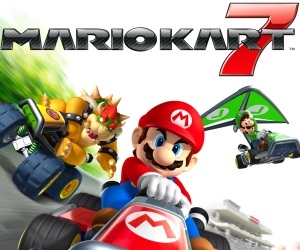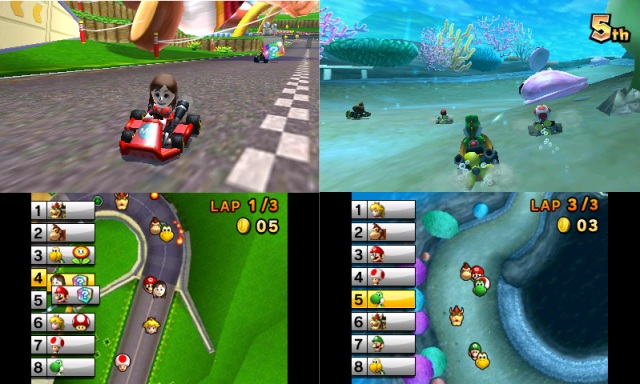Mario Kart 7 Review
 Game: Mario Kart 7
Game: Mario Kart 7
Developer: Nintendo
Publisher: Nintendo
Available on: Nintendo 3DS only
Despite a rather lacklustre start to its life, the Nintendo 3DS is really coming into its own at the moment. With incredible titles such as Super Mario 3D Land released, Nintendo have seen fit to follow that up with another Mario-led title, Mario Kart 7. Have they scored another victory or are the Karting franchises’ best days behind it?
As you’d expect from a seventh entry into the series, Mario Kart 7 is fairly straightforward and to the point. Starting up the game for the first time you’ll be faced with the traditional choice of 50cc, 100cc and 150cc races (these are the difficulty levels) which all take place throughout 8 different cups, from Mushroom to Leaf. There’s a bounty of courses split between theses, some new and some recycled and tarted up from previous entries onto the Game Boy Advance, Nintendo 64, SNES and so forth.
The traditional and time honoured method of four races per cup and points for placement are all present and correct, along with the old favourite power-ups (and yes, the damned blue shell is back) with some new ones thrown in for good measure. A nod to Super Mario 3D Land is present in the tanooki tail power up, which allows you to swing your tail at enemies and defend against some projectile attacks. Likewise, the fire-flower is here too, allowing you to throw fireballs in front or behind of you to attack your enemies.
In terms of gameplay, Mario Kart 7 is a culmination of all that has come before it, with a few new twists. Whereas before, in a Mario Kart game, if you went off the beaten path into a lake you would need to be fished out and sat back on the track (in exchange for coins), now you have a new addition to your chosen Kart; a propeller. This is actually a fairly odd addition, because it basically removes the danger from going near water, but at the same time allows for more creative course design. It’s a risky decision but for the most part the course design makes it a worthy one and there is more than enough danger from the power-ups and opponent AI to worry about anyway.

Also new is the glider, which is the better of the two main new features. Even on the recycled courses there have been moments added that if you are jumping high enough, the glider will automatically open and you can steer over your opponents heads into first place, making for some truly elating moments. Some of the ever-present green pipes even have air blowing from them to allow you to travel further or find hidden parts of the course, gaining that all important advantage in-race.
If you fancy it, you can use the 3DS’ motion controls to steer your vehicle in first person mode, which adds yet another twist to the gameplay. This works as well as you’d expect, but of course moving the 3DS around too vigorously means that the 3D effects will be distracting, so most people will probably end up playing in the traditional Mario Kart view.
Either way, the A.I. is fiendish and, as you progress through the difficulties, you will end up tearing your hair out at how often they’ll grab a red or blue shell and annihilate you from miles away. The much maligned rubberbanding from throughout the series does appear to make a comeback but it is far less prevalent and actually increases the quality of the lower-difficulty experience. At the 50cc level you will romp to first place within the first lap and stay there until the end, despite the opponent A.I. trying to get at you. At 100cc, a decent player will still probably be able to maintain first place throughout any given cup, but the A.I. will pose more of a challenge, requiring you to use more skill and tactical use of power-ups. 150cc is exactly what you’d expect; a far greater challenge. You won’t ever get far enough ahead of other racers to notice any blatant rubberbanding, but it also provides a wholly different experience. At 50cc, power-ups are insignificant and you won’t need to find shortcuts or be clever at all, but at 150cc you’ll most certainly need to be on top of your game to win. For a change, the difficulty actually matters and makes for a different experience.

Throughout the progress of playing the cups, you will also be collecting a maximum of 10 coins per race, which all add up to unlock more kart styles, glider styles and different wheel types. They tend to unlock at every 50 coins and are collected both on and offline, which is a nice touch.
Along with the regular cups, there are also other modes. Time trials are exactly what you’d imagine, allowing you to race against preset ghosts or friend’s spotpassed ghosts, or even times of online players, which are very challenging to beat. Balloon Battle is also back, allowing you to take on up to 7 other racers to score points for each time you pop a balloon. This takes place over a series of courses and is tremendous fun both on and offline. Coin Battle is the final game mode, which tasks you with collecting as many coins as you can throughout the course of a battle style map, again with power-ups to sort the men from the boys.
Similar to the Wii incarnation, there is a “Mario Kart Channel” included in Mario Kart 7 which will show you any new ghost data that has arrived via Spotpass, or give you an update on your community reccomendations. To round off the channel there is also a stats screen which shows you how many VR points you have (the scoring system for the title), how many wins and losses you have, how many coins you have collected and how many StreetPass hits you have received.
So it’s fair to say that Mario Kart 7 has a fair amount to offer, especially for a handheld game. On top of all these gameplay elements, new and old, Mario Kart 7 looks pretty nice as well. Just like Super Mario 3D Land, the 3D effects aren’t intrusive at all, in fact they are subtle and you’ll forget you are even playing in 3D, even with the slider set to full. As you’d expect, a lot of the sound effects are reused or have been heard before elsewhere, with classic tunes given a reworking or remixing. The norm for a Mario-led game is for it to look colourful and charming, whilst having some catchy little ditties; Mario Kart 7 is exactly that.
The previous title in the series, Mario Kart Wii, had a fully featured online mode which Mario Kart 7 pretty much apes throughout. You can take to the internet against random foes or you can play friends by trading friend codes. With the new 3DS update allowing you to literally join a game from the friend list, this is easier than ever…or so you’d think.

Oddly, there appears to be no way to create a game, instead you can simply either join a random match already in progress, or join a friend’s race already in progress. The solution is to create a community – this gives you another numerical code (longer than a friend code) which you can share with friends, which allows you to simply join that community, this in turn creates a lobby that you and all your friends can get together in and race. It works, but it’s needlessly convoluted and slightly negates the point of having a “Friends/Opponents” section in the online multiplayer mode, unless you particularly fancy racing random people you’ve already raced before. Local Multiplayer is obviously also included, you just need to create a group, let people join it and you are away.
VERDICT: Like previous Mario Kart titles, Mario Kart 7 is a lot of fun in single player until a certain point, but lives and dies by the multiplayer action. It could be a lot easier to get going with the online modes, but once there you’ll adore playing against friends and have a constant grin upon your face whilst doing so.
Mario Kart 7 is nowhere near a revolution to the series but it really is a welcome addition to the Nintendo 3DS. If you have already invested in the system it’s a no-brainer, it just isn’t quite the system seller that a title like Super Mario 3D Land is.





